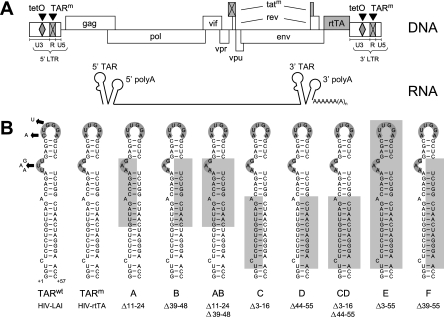FIG. 1.
TAR mutations introduced in the dox-dependent HIV-rtTA. (A) A schematic of the HIV-rtTA genome is shown, with the LTR region subdivided into the U3, R, and U5 domains. Transcription starts at the first nucleotide of the 5′ R region, and the RNA transcripts are polyadenylated at the last nucleotide of the 3′ R region. Both the 5′ and the 3′ ends of the RNA molecule can fold a TAR and poly(A) hairpin. In the HIV-rtTA virus, the Tat-TAR axis of transcription regulation has been inactivated by mutation of both Tat and TAR (tatm and TARm; crossed boxes). Transcription and replication of the virus was made dox dependent by the introduction of tetO elements in the U3 promoter region and by replacing the Nef gene with the rtTA gene. (B) HIV-rtTA is based on the HIV-1 molecular clone LAI, which contains a 57-nt wild-type TAR hairpin (TARwt). In HIV-rtTA, TAR was inactivated by nucleotide substitutions in both the bulge and loop motifs (TARm). The TARm sequence was partially or nearly completely deleted (mutants A to F). The deleted nucleotides are boxed in gray. All mutations were introduced in both the 5′ and 3′ LTR of HIV-rtTA.

